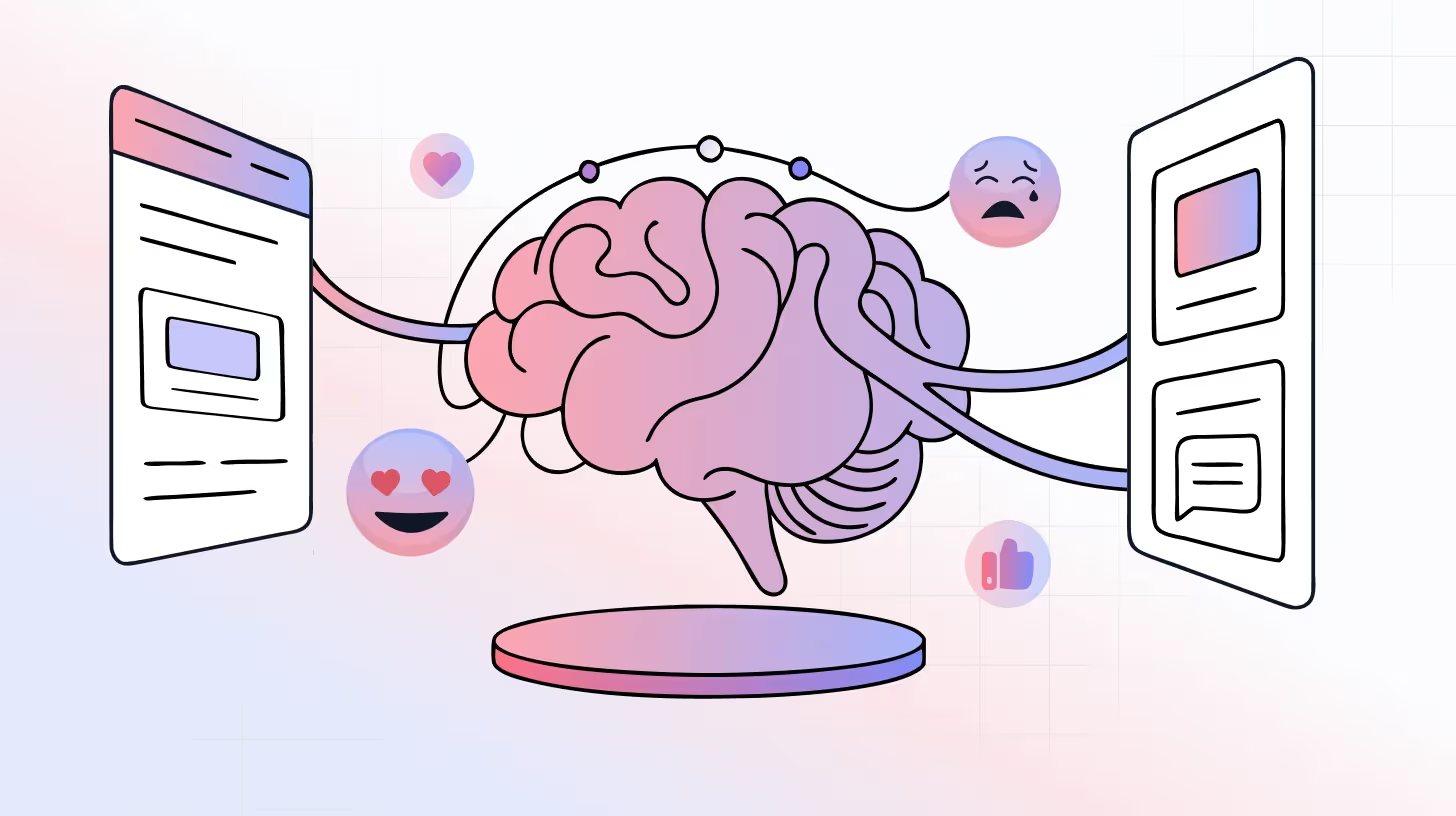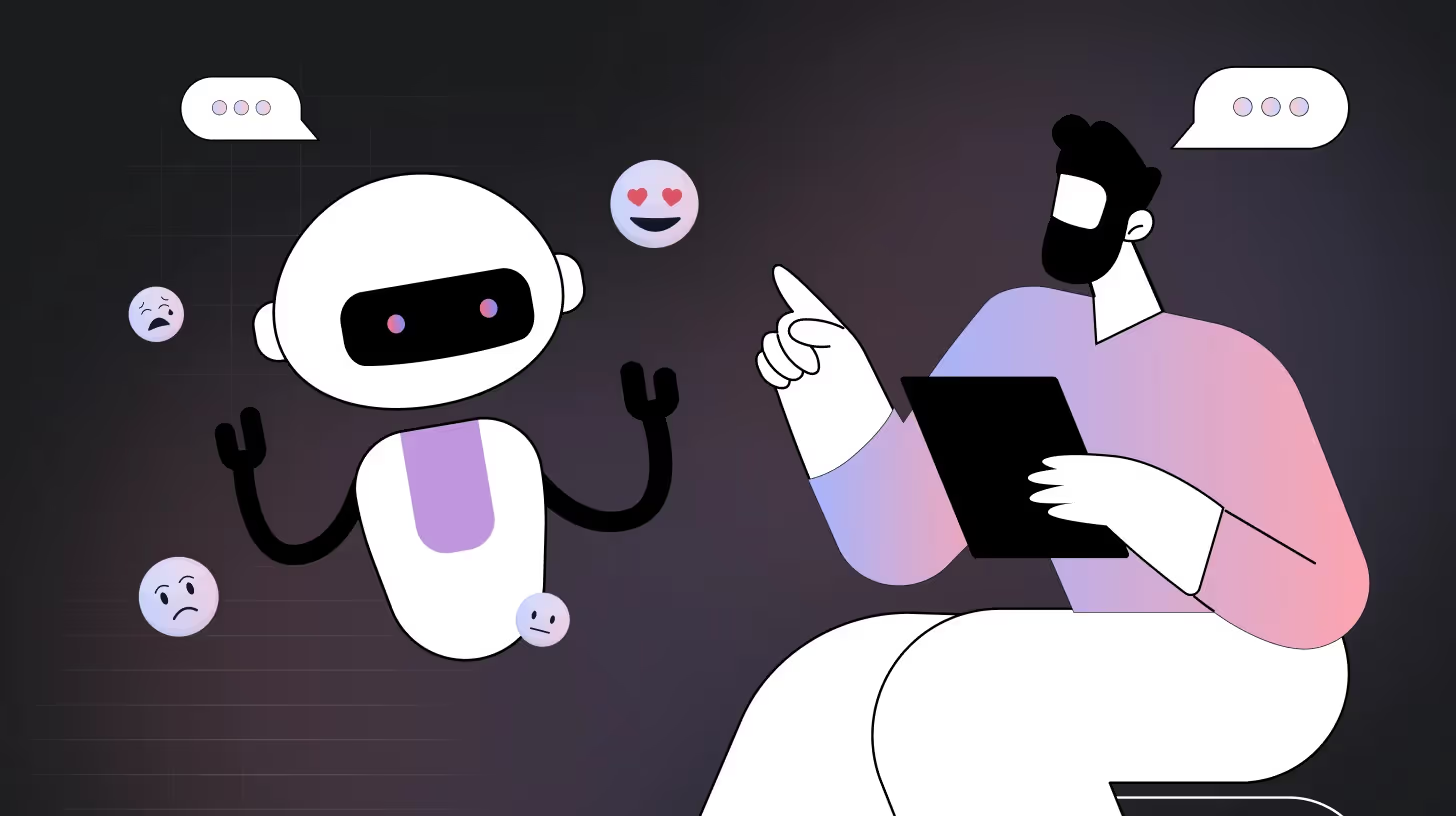 Blog
Blog The Role of AI in Building Emotionally Intelligent Brands
The Role of AI in Building Emotionally Intelligent BrandsThe Role of AI in Building Emotionally Intelligent Brands

You don’t buy a pair of sneakers, you buy the belief that you can “Just Do It.” You don’t just use a phone, you join a movement that says you’re a creator, a visionary, a rebel.
That’s not just brilliant marketing but emotional intelligence in branding, and today, AI is amplifying it.
Brands like Nike and Apple don’t just win because they shout the loudest, but because they connect deeply with their audience instantly. They understand what their audience is and what drives their choices.
However, in 2025, emotional intelligence is no longer just for the creative elite. With the rise of AI, brands of all sizes can now understand customer emotions, personalize experiences, and build lasting loyalty all at scale.
We've already entered into a new era where data meets empathy, where automation can feel human, and where AI helps brands listen not just to what customers say, but to what they feel.
So, how exactly is AI helping brands become more emotionally intelligent? Let’s explore.
What Is an Emotionally Intelligent Brand?
An emotionally intelligent brand listens and understands customers on an emotional level. It’s the ability to recognize customer emotions (joy, frustration, excitement), respond with empathy and relevance, and build trust over time through authentic, meaningful interactions.
Emotional Branding vs. Emotional Intelligence
Emotional branding is creating a vibe of a brand by associating a consistent emotion with it. For example, Coca-Cola is associated with happiness, and Harley-Davidson is associated with freedom.
Emotional intelligence, on the other hand, is dynamic; it’s associated with the awareness of shifting emotions and responding to them in real time.
Let’s break that down through examples:
Spotify
Spotify provides more than simply playlists; it also offers personalized moments. Through emotional AI, Spotify tracks not just your listening habits, but also emotional states: nostalgia, excitement, focus. Features like Your Time Capsule or Mood Booster are powered by emotion detection and refined through empathetic tech that responds to more than just behavior—it responds to feelings.
Airbnb
Airbnb does not lead with pricing or property specifications. It starts with belonging.
Airbnb's tagline ("Belong anywhere") and its emotive host stories and guest comments tap into the universal urge for connection, particularly in unfamiliar places. Yes, its platform uses AI to match you with listings that fit your tastes, but it also takes into account the host's personality, cultural context, and community experiences.
Headspace
Mental wellness isn't one-size-fits-all, and Headspace understands that. Its app uses AI to recommend meditations, breathing exercises, or sleep sessions based on your emotional condition. Are you feeling anxious? The app adjusts its tone. Struggling to sleep? It softens content delivery by darkening the graphics and decreasing the voice tone.
Headspace's AI does more than merely push material; it also responds to your emotional state, providing a sense of support and presence when you need it the most.

Case Study: BenchSci — Emotional AI Without Conversations
BenchSci, a leading life sciences platform, supports pharmaceutical giants where strict data privacy regulations prohibit call recordings, a significant hurdle for customer-facing teams who rely on conversational insights.
The Challenge
How can you apply emotional intelligence in branding when you can’t record conversations?
The AI-Powered Solution
BenchSci adopted an AI conversational intelligence platform capable of analyzing non-verbal customer interactions, including:
- Emails
- Support tickets
- Survey responses
This platform performed behavioral and personality analysis to detect emotional signals in written communication. These insights empowered customer success managers to adapt their tone, timing, and messaging even without hearing the customer’s voice.
Impact on Customer Empathy
- Delivered personalized, emotionally aligned support
- Enabled proactive engagement based on sentiment and behavioral cues
- Boosted customer satisfaction and evangelism
Mike Egan, VP of Customer Success at BenchSci, noted that this emotional AI approach helped his team deliver the right support at the right time, turning satisfied users into brand advocates.
Source: Limon, D., & Plaster, B. (2022, January 25). Can AI Teach Us How to Become More Emotionally Intelligent? Harvard Business Review.
How AI Powers Emotional Intelligence in Branding
At its core, emotional intelligence is about connection. It’s more like brands understand you not just as customers but as a person. Now imagine doing it for millions of people. That’s where AI comes in, becoming a brand’s emotional compass.
Let’s see how AI makes it possible:
Sentiment Analysis & Natural Language Processing (NLP)
AI reads between the lines. When customers leave a review, conduct a survey, or contact support, AI-powered NLP tools examine the tone, intent, and emotion in their language. Are they frustrated? Excited? Disappointed?
For instance, an organization can use AI to identify 40% of "positive" reviews that include phrases like "finally" or "about time," signaling relief rather than satisfaction. That nuance drives sharper communications and product enhancements.
Voice and Facial Emotion Recognition
Some AI tools can interpret speech indicators (such as pitch, speed, and stress) to determine how someone is truly feeling during a support call or video session.
Retailers, banks, and even mental health platforms are now using these technologies to
- Detect emotional anguish.
- Enable real-time support.
- Provide empathy-driven responses.
An unhappy caller may raise their voice subtly. AI picks it up, and the chatbot instantaneously switches tone: "I hear you. Let us work together to fix this." This is digital emotional intelligence at work.
Predictive Emotional Modeling
Some AI tools can understand speech cues such as pitch, speed, and stress. What if you could predict how someone will feel before they say it?
AI can achieve this by analyzing past behavior (such as buying history, session duration, and feedback tone) to predict future emotional states. It's like having a sixth sense for brands.
For instance, if a consumer browses cancellation policies, reads negative reviews, and ignores emails, AI may identify them as "disengaged." You can intervene with a personalized check-in before they churn.
Conversational AI with Emotional Awareness
Modern chatbots are no longer robotic. Emotional AI allows them to imitate human empathy.
For instance, instead of stating "Your request is being processed," an emotionally intelligent bot could say, "I understand how frustrating it is to wait." "Let me speed this for you."
Even minor tonal adjustments like these promote emotional resonance — and trust.
AI-Powered Interviews & Surveys
Unlike static forms, AI interviews can:
- Adjust questions in real-time based on sentiment
- Adapt tone to keep the conversation engaging.
- Extract deeper insights from open-ended responses.
Example:
TheySaid uses AI to conduct dynamic interviews that “listen,” emotionally capturing what customers mean, not just what they type. It’s a massive leap beyond traditional surveys.
Recommended read: How Different Generations Use AI in 2025

Use Cases: How Brands Are Using Emotional AI
Personalizing the Customer Journey
People don’t want to feel like they’re just another data point. Emotional AI helps brands recognize when someone’s feeling confused, excited, rushed, or even frustrated and tailor the experience accordingly.
- If someone’s calm, a gentle upsell might make sense.
- If they seem annoyed, maybe hold the pitch and just help.
- If they’re pumped? Perfect time to offer a referral nudge.
Strengthening Customer Support
You can have the best product in the world, but if your support feels cold or dismissive, people won’t stick around. AI helps support teams pick up on cues that something’s off even if the message looks polite on the surface.
- It can flag a message that sounds frustrated, even if there are no exclamation marks.
- It helps reps respond with empathy, not just canned replies.
- It puts the right tone in the right moment, which can make all the difference.
Enabling Smarter Sales Conversations
Selling is all about connection, and AI makes that connection easier to read.
- If a prospect sounds uncertain, you can soften your pitch.
- If they’re enthusiastic, you can move forward more confidently.
- And if they’re checked out entirely? Time to re-engage or rethink your approach.
Driving Emotion-Led Product Prioritization
Product teams often look at what’s broken or requested the most. But what if you also looked at what’s frustrating people the most? Or what’s delighting them unexpectedly?
AI can spot those signals.
- It shows which friction points are causing emotional drop-offs.
- It helps you prioritize things that users care deeply about — not just those that are loudly discussed.
- It surfaces those surprise moments of joy you might want to lean into.
Emotion-Aware Marketing Optimization
Marketing isn’t just about getting attention anymore; it’s about making people feel something. AI helps teams determine the most effective tone and when to use it.
- Maybe urgency works better on a Monday, but reassurance works better on Friday.
- Maybe a playful tone clicks with one segment but turns another off.
- Maybe one campaign’s wording felt “off” — even if the numbers looked fine.
Brand Use Cases by Industry
Recommended read: How to Give an Interview Using AI (Step-by-Step Guide for Job Seekers)
The Ethics of Emotion: Where AI Can Go Wrong
As emotional AI becomes more advanced, ethical lines get blurrier. Empathetic tech must be designed to support—not manipulate. If emotion detection is used without transparency or inclusivity, it can backfire. Emotion is personal, and how AI in branding handles it must be too.
Here’s where things can get messy:
1. When AI crosses the line from empathy to manipulation
Let’s say someone’s having a rough day. They scroll past an ad, and the AI knows they’re vulnerable, so it triggers a message designed to sell. Not supported. That’s not emotional intelligence — that’s emotional exploitation. And people can feel it.
2. When AI misunderstands human nuance
AI doesn’t feel. It infers. But humans are messy, layered, and often don’t even understand our own emotions in the moment. An annoyed tone might be stress, not anger. A blank face might hide grief. If brands rely too heavily on machines to decode that complexity, they risk making people feel misunderstood — or worse, invisible.
3. When AI isn’t inclusive
Emotions show up differently across cultures, genders, neurotypes, and identities. If AI is trained on narrow data, it might not recognize joy in one face or pain in another.
That’s more than a technical failure — it’s an ethical one. Everyone deserves to be seen, not just those who fit the model.
4. When people don’t know they’re being read
Most of us never signed up to have our tone, face, or micro-expressions analyzed by a machine. If brands use emotional AI without being clear about it, it breaks trust.
And no amount of personalization can repair that kind of breach.
The Future of AI: What’s Coming Next in Emotional Intelligence
Today’s AI is already impressive. It can read tone, analyze text, and pick up on how people feel. But what’s coming next is even more exciting and a little mind-blowing. The future is about AI that doesn’t just understand emotions, but actually responds to them in real-time. Here’s a glimpse of what’s just around the corner:
Real-Time Emotionally Aware Sales Agents
Imagine talking to a sales assistant who can sense your frustration and gently shift their tone right then and there. Future AI agents will be able to adjust their pitch, wording, and pace in real time, just like a thoughtful human would in conversation.
Empathetic Virtual Avatars
These aren’t your average chatbots. Think digital humans that blink, smile, lean in, and actually feel like they’re listening. Whether it’s for customer support, therapy, or coaching, these avatars could completely change how we connect online.
Cross-Channel Emotional Memory
Ever wish companies remembered how you felt the last time you spoke to them? Future AI will. Whether you messaged support, left a review, or had a call — it’ll carry that emotional context across channels. No more starting over every time.
Empathy-Driven Advertising
Forget creepy personalization. Instead of just targeting based on your age or interests, future ads will read the room. They’ll know when you’re in the mood to explore, to laugh, or to scroll right past — and they’ll shift tone accordingly.
Emotionally Responsive Devices
Your smartwatch or car might soon do more than track steps or play music. If it senses you’re stressed, it could dim the lights, cue up calming sounds, or reroute you away from traffic. It’s like having a tiny emotional support system everywhere you go.
Want to Truly Understand Your Customers? Start With a Conversation.
Most brands think they know their audience. They track clicks, views, and purchase patterns, but they miss the why behind the behavior.
That’s where TheySaid changes the game.
It’s not just another survey tool. It uses conversational AI to uncover how your customers feel, not just what they do. It picks up on frustration, excitement, confusion, and trust. It adapts questions in real-time based on tone, emotion, and intent. You get insights that go beyond the surface.
Imagine knowing:
- Why people almost churned… but stayed.
- What made someone feel truly seen by your support team?
- Which part of your brand story sparked an emotional connection?
That’s the kind of understanding that drives loyalty, advocacy, and long-term love.
TheySaid helps you build emotionally intelligent relationships — at scale.
If you're serious about emotional resonance, not just ROI, now's the time to listen differently.
Try TheySaid and meet the real voice of your audience.
Key Takeawys
- Use emotional AI tools to analyze customer sentiment, not just actions
- Combine AI automation with real human empathy in customer journeys
- Train teams to recognize emotional signals in customer communication
- Deliver emotionally personalized experiences across touchpoints
- Segment users by emotional behavior (e.g., frustration, excitement)
- Track emotional KPIs like mood shifts and churn warning signs
- Leverage AI-driven insights to time empathetic responses
- Use emotion detection AI to support — not replace — real connection
FAQs
What is emotional AI in branding?
Emotional AI in branding refers to the use of artificial intelligence tools to detect, understand, and respond to customer emotions across interactions — helping brands create more personalized and empathetic experiences.
How does AI detect emotions from customers?
AI uses technologies like Natural Language Processing (NLP), sentiment analysis, facial recognition, and voice tone analysis to interpret emotions from texts, calls, emails, or survey responses.
Can AI really understand human emotions?
While AI can’t “feel” emotions, it can recognize patterns in language and behavior to accurately detect emotional states and help brands react more appropriately.
Is emotional AI available for small businesses?
Yes. Many platforms now offer scalable emotional AI tools for startups and small businesses — especially in customer support, feedback analysis, and sales enablement.















.svg)